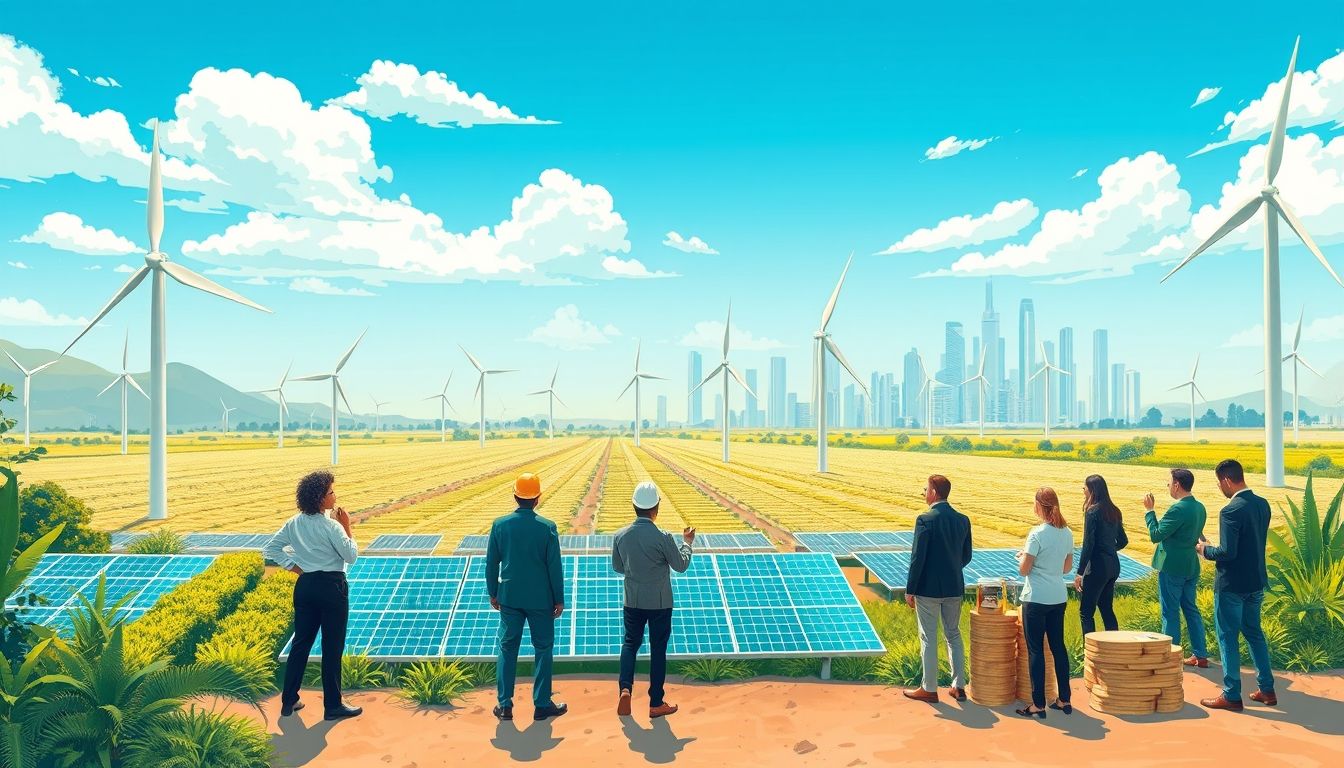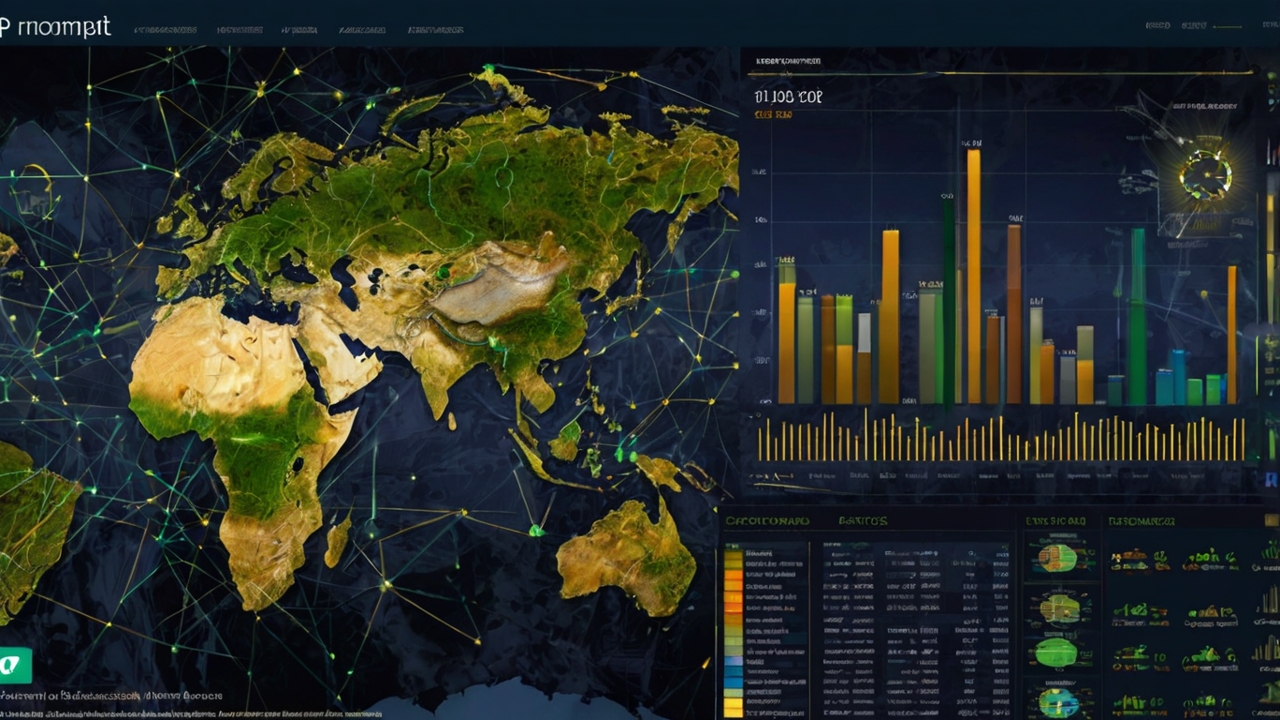تمويل مشاريع الطاقة المتجددة: فرص وتحديات الأسواق الناشئة
يشهد العالم تحولاً متسارعاً نحو مصادر الطاقة المتجددة، مدفوعاً بالضرورة الملحة لمكافحة تغير المناخ وتحقيق التنمية المستدامة. تبرز الأسواق الناشئة كلاعب رئيسي في هذا التحول، حيث تمتلك إمكانات هائلة لتوليد الطاقة النظيفة من مصادر مثل الشمس والرياح والطاقة المائية. ومع ذلك، يواجه هذا القطاع تحديات تمويلية كبيرة تعيق نموه الكامل.
الفصل الأول: أهمية الطاقة المتجددة في الأسواق الناشئة
تمتلك الأسواق الناشئة العديد من المزايا التي تجعلها وجهة جاذبة للاستثمار في الطاقة المتجددة:
- وفرة الموارد الطبيعية: تتمتع هذه الدول بموارد طبيعية وفيرة مثل أشعة الشمس القوية والرياح المستمرة، مما يجعلها مثالية لتوليد الطاقة الشمسية وطاقة الرياح.
- الطلب المتزايد على الطاقة: يشهد العديد من هذه الدول نمواً اقتصادياً سريعاً وزيادة في عدد السكان، مما يؤدي إلى ارتفاع الطلب على الطاقة.
- الحاجة إلى تنويع مصادر الطاقة: تسعى هذه الدول إلى تقليل اعتمادها على الوقود الأحفوري المستورد، مما يعزز أمن الطاقة ويقلل من تقلبات الأسعار.
- الالتزام بأهداف التنمية المستدامة: تلتزم العديد من هذه الدول بتحقيق أهداف التنمية المستدامة للأمم المتحدة، بما في ذلك الهدف السابع المتعلق بالطاقة النظيفة وبأسعار معقولة.
الفصل الثاني: الفرص الاستثمارية في قطاع الطاقة المتجددة
تتنوع الفرص الاستثمارية في قطاع الطاقة المتجددة في الأسواق الناشئة، وتشمل:
- محطات الطاقة الشمسية: بناء وتشغيل محطات الطاقة الشمسية الكهروضوئية المركزة.
- مزارع الرياح: تطوير وتشغيل مزارع الرياح البرية والبحرية.
- محطات الطاقة المائية: إنشاء محطات الطاقة المائية الصغيرة والكبيرة.
- مشاريع الطاقة الحيوية: تحويل الكتلة الحيوية إلى طاقة كهربائية أو حرارية.
- حلول الطاقة خارج الشبكة: توفير حلول الطاقة المتجددة للمجتمعات النائية التي لا تتوفر لديها الكهرباء.
مثال: في المغرب، تم إطلاق مشروع نور للطاقة الشمسية، وهو أحد أكبر مشاريع الطاقة الشمسية المركزة في العالم، مما جذب استثمارات أجنبية كبيرة وساهم في تحقيق أهداف الطاقة المتجددة في البلاد.
الفصل الثالث: التحديات التمويلية التي تواجه مشاريع الطاقة المتجددة
على الرغم من الفرص الواعدة، تواجه مشاريع الطاقة المتجددة في الأسواق الناشئة العديد من التحديات التمويلية:
- ارتفاع التكاليف الأولية: تتطلب مشاريع الطاقة المتجددة استثمارات أولية كبيرة في التكنولوجيا والبنية التحتية.
- صعوبة الحصول على التمويل: قد يواجه المستثمرون صعوبة في الحصول على التمويل من البنوك والمؤسسات المالية بسبب المخاطر المتصورة المرتبطة بهذه المشاريع.
- تقلب أسعار صرف العملات: يمكن أن يؤثر تقلب أسعار صرف العملات على العائدات المتوقعة للمستثمرين الأجانب.
- المخاطر السياسية والتنظيمية: يمكن أن تؤثر التغييرات في السياسات الحكومية واللوائح التنظيمية على جدوى المشاريع.
- نقص الخبرة الفنية: قد يكون هناك نقص في الخبرة الفنية المحلية لتطوير وتشغيل مشاريع الطاقة المتجددة.
الفصل الرابع: مصادر التمويل المتاحة لمشاريع الطاقة المتجددة
تتوفر العديد من مصادر التمويل لمشاريع الطاقة المتجددة في الأسواق الناشئة، بما في ذلك:
- التمويل الخاص: يشمل الاستثمارات المباشرة من الشركات الخاصة وصناديق الاستثمار وشركات رأس المال المخاطر.
- التمويل العام: يشمل القروض والمنح من الحكومات والمؤسسات الدولية مثل البنك الدولي وبنك التنمية الآسيوي.
- التمويل المختلط: يجمع بين التمويل الخاص والعام لتقليل المخاطر وزيادة جاذبية المشاريع.
- التمويل الجماعي: يسمح للأفراد والشركات الصغيرة بالمساهمة في تمويل المشاريع مقابل الحصول على عائدات أو مزايا أخرى.
- السندات الخضراء: هي سندات يتم إصدارها لتمويل مشاريع صديقة للبيئة، بما في ذلك مشاريع الطاقة المتجددة.
الفصل الخامس: دور المؤسسات المالية الدولية
تلعب المؤسسات المالية الدولية دوراً حاسماً في تمويل مشاريع الطاقة المتجددة في الأسواق الناشئة من خلال:
- تقديم القروض والمنح: توفر هذه المؤسسات التمويل اللازم لتطوير المشاريع.
- تقديم الضمانات: تساعد الضمانات على تقليل المخاطر بالنسبة للمستثمرين الخاصين.
- تقديم المساعدة الفنية: تساعد هذه المؤسسات على بناء القدرات المحلية وتطوير المشاريع.
- تطوير السياسات: تعمل هذه المؤسسات مع الحكومات على تطوير سياسات داعمة للطاقة المتجددة.
الفصل السادس: دور الحكومات في تعزيز الاستثمار في الطاقة المتجددة
تلعب الحكومات دوراً محورياً في تهيئة بيئة مواتية للاستثمار في الطاقة المتجددة من خلال:
- وضع سياسات داعمة: وضع أهداف طموحة للطاقة المتجددة وتقديم حوافز مالية وضريبية للمستثمرين.
- تبسيط الإجراءات التنظيمية: تسهيل الحصول على التراخيص والموافقات اللازمة لتطوير المشاريع.
- ضمان استقرار الإطار القانوني: توفير إطار قانوني واضح ومستقر يحمي حقوق المستثمرين.
- الاستثمار في البنية التحتية: تطوير شبكات الكهرباء لنقل الطاقة المتجددة بكفاءة.
- بناء القدرات المحلية: تدريب وتأهيل الكوادر المحلية لتطوير وتشغيل المشاريع.
الفصل السابع: نماذج ناجحة لتمويل مشاريع الطاقة المتجددة
هناك العديد من النماذج الناجحة لتمويل مشاريع الطاقة المتجددة في الأسواق الناشئة، بما في ذلك:
- الشراكة بين القطاعين العام والخاص (PPP): يجمع هذا النموذج بين خبرات القطاعين العام والخاص لتطوير المشاريع.
- اتفاقيات شراء الطاقة (PPA): تضمن هذه الاتفاقيات للمستثمرين الحصول على عائدات ثابتة من بيع الطاقة.
- مزادات الطاقة المتجددة: تسمح هذه المزادات للمستثمرين بالتنافس على عقود لتوليد الطاقة المتجددة.
مثال: في الأردن، تم استخدام نموذج اتفاقيات شراء الطاقة (PPA) بنجاح لجذب استثمارات كبيرة في مشاريع الطاقة الشمسية وطاقة الرياح.
الفصل الثامن: المخاطر وكيفية إدارتها
ينطوي الاستثمار في مشاريع الطاقة المتجددة على بعض المخاطر، ولكن يمكن إدارتها من خلال:
- إجراء دراسات الجدوى الشاملة: لتقييم المخاطر المحتملة وتحديد الحلول المناسبة.
- التأمين: لحماية الاستثمارات من الخسائر الناجمة عن الكوارث الطبيعية أو الأحداث السياسية.
- تنويع الاستثمارات: لتقليل المخاطر الإجمالية للمحفظة الاستثمارية.
- إدارة المخاطر السياسية: من خلال الحصول على ضمانات من الحكومات أو استخدام أدوات التحوط.
الفصل التاسع: التكنولوجيا والابتكار في قطاع الطاقة المتجددة
يلعب التكنولوجيا والابتكار دوراً حاسماً في خفض تكاليف الطاقة المتجددة وتحسين كفاءتها:
- تطوير تقنيات جديدة: مثل الخلايا الشمسية الأكثر كفاءة وتوربينات الرياح الأكبر حجماً.
- استخدام الذكاء الاصطناعي: لتحسين إدارة شبكات الكهرباء والتنبؤ بإنتاج الطاقة المتجددة.
- تطوير حلول تخزين الطاقة: مثل البطاريات ومحطات الطاقة المائية لتخزين الطاقة المتجددة الزائدة.
الفصل العاشر: مستقبل الاستثمار في الطاقة المتجددة في الأسواق الناشئة
يبدو مستقبل الاستثمار في الطاقة المتجددة في الأسواق الناشئة واعداً، مدفوعاً بالطلب المتزايد على الطاقة النظيفة، وتراجع تكاليف التكنولوجيا، والالتزام بأهداف التنمية المستدامة. ومع ذلك، يتطلب تحقيق هذا الإمكان الكامل معالجة التحديات التمويلية والتنظيمية القائمة.
خلاصة: يتطلب تمويل مشاريع الطاقة المتجددة في الأسواق الناشئة اتباع نهج شامل يجمع بين التمويل الخاص والعام، ودعم الحكومات، والابتكار التكنولوجي، وإدارة المخاطر الفعالة. من خلال العمل معاً، يمكننا تسريع التحول نحو مستقبل طاقة مستدامة للجميع.




